Content
Kermek Tatar (limonium tataricum) is a herb belonging to the Pig family and the order of Cloves. Its other names are lemongrass, statice, tumbleweed. Found in southern and steppe regions around the world. On the Eurasian continent, it can be found in Altai and Western Siberia, on the shores of the Mediterranean Sea and in Central Asia. Perennial Tatar Kermek, whose photos are striking in their fragile beauty, is very popular with flower growers. It is widely used in landscape design. Translated, his name means "persistent", as this unpretentious plant can be found even in the sands.
General description of the perennial
Kermek Tatar is a perennial herb, less often a shrub. Large, elongated-oblong lanceolate leaves are located in the root area. Dense, leathery, with a glossy sheen. They have a green, bright light green or grayish emerald color. Stems are thin, flexible, branched, green, usually not more than 50 cm high. The shape of the bush is spherical.
Kermek Tatar blooms in early summer. Panicle inflorescences are located at the ends of the shoots. The flowers are small, five-petal, bell-shaped, with filamentous stigmas. The color is light pink, white, cream, rich cornflower blue, light lavender. Many varieties combine buds of two colors on the same inflorescence, for example, white and blue.
Common types
Breeders have developed decorative varieties with a wide variety of characteristics. The most popular of them are only a few types.
Caspian
Kermek Tatar "Caspian" refers to perennials. The maximum height of the bushes is 0.5 m. The flowers are painted in a light lavender, pale purple color. The shape of the inflorescences is thyroid.
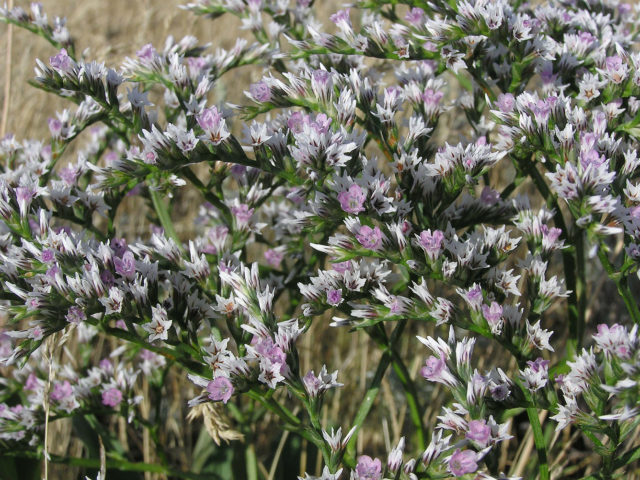
Compact balls covered with miniature flowers are graceful and full of charm
Sinuate
This type of Tatar Kermek is annual. The tall shrub reaches 80 cm. The inflorescences are corymbose, and the petals of the buds are of a rich cornflower blue hue.
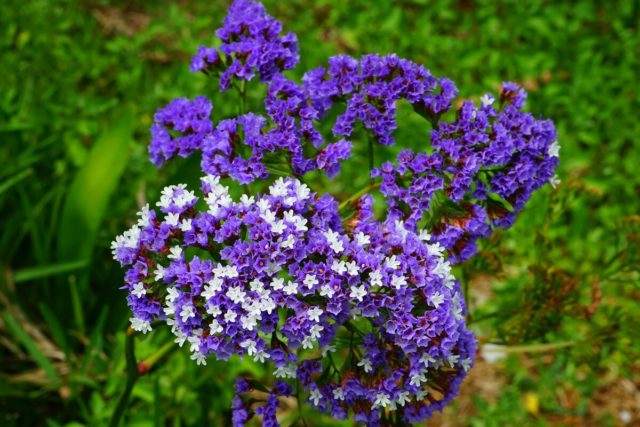
Kermek Tatar "Vymchaty" - a great option for decorating the front garden
Gmelin
A perennial variety, undersized, compact bushes do not exceed 30-40 cm. Large emerald-green leaves form a rosette in the root part of the trunk. The stems are abundantly covered with small flowers of a delicate violet and lilac color. The root of this variety of Kermek Tatar has pronounced medicinal properties.
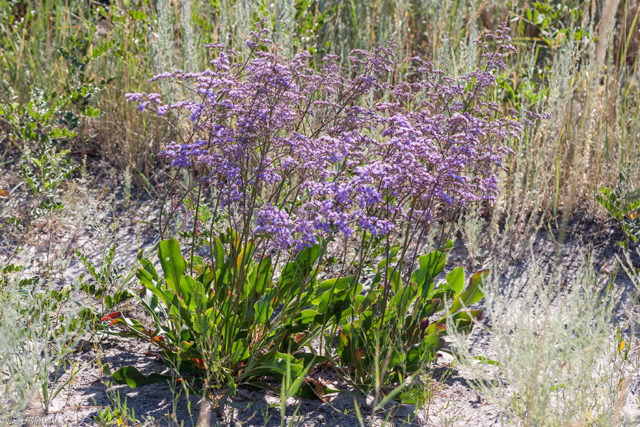
Inflorescences of the "Gmelin" variety have a shield shape
Tatar Kermek in landscape design
Most often, the perennial Kermek Tatar is used in landscape design to create rockeries and alpine slides. It is excellent in mixborders and in ordinary flower beds. Looks harmoniously against the background of green lawns, in the vicinity of dwarf conifers.
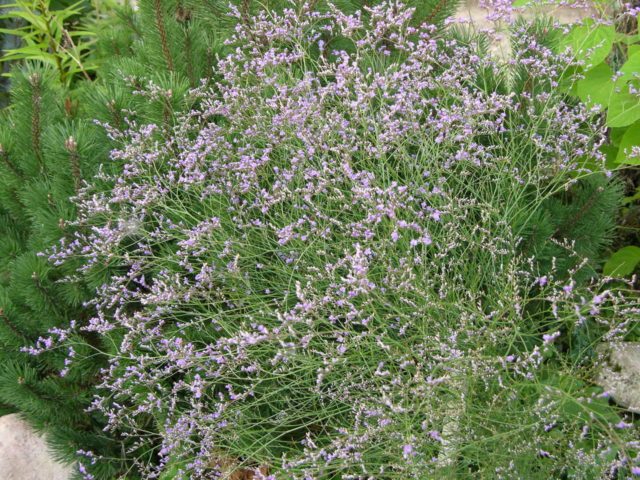
The interlacing of thin stems, strewn with delicate flowers, looks touchingly defenseless, creating an atmosphere of peace and comfort
Breeding features
Tartar white limonium is usually grown from seeds. Since the root of the rhizome of the plant goes to a great depth, it makes no sense to transplant or divide it: bushes with damaged roots take root very poorly.
Growing Tatar Kermek from seeds
Kermek Tatar is surprisingly unpretentious and hardy. It is not difficult to grow an adult bush from seeds. Even beginner growers and those who first decided to plant this unusual plant on their site successfully cope with the task. The main thing in the planting process is to follow the simple rules of agricultural technology.
Sowing terms and rules
Tatar Kermek seedlings can be planted in February-March, depending on the climatic conditions of the area. The seeds are placed in individual peat pots so as not to disturb the sensitive roots later. The soil is slightly moisturized. For sowing, a sand-peat mixture is suitable, without the addition of humus and fertilizers. You can replace peat with light turf soil.
Seedling care
As soon as the first shoots appear, and this happens after a week, it is necessary to provide good lighting. Watering is carried out neatly, in a thin stream, at the root. Seedlings are planted in a permanent place in early May.
Planting and caring for the Tatar Kermek in the open field
Kermek Tatar is a plant for open ground. The increased humidity of greenhouses and closed rooms with a lack of sunlight act depressingly on him. He is very sensitive to the length of daylight hours, he does not like shady places. Planting and caring for the Tatar Kermek is easy enough, the process is not a hassle.
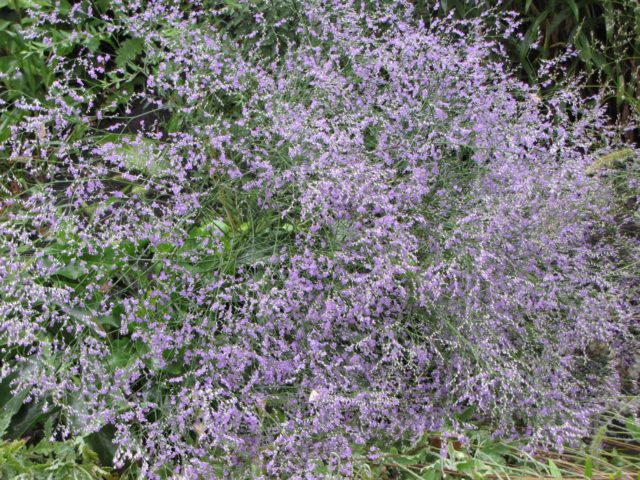
Kermek Tatar must be planted in such a way that the bushes can grow without interfering with each other
Timing
Kermek Tatar seeds are planted in the ground in early spring, as soon as the snow melts and the soil warms up enough. Depending on the region and weather conditions, it could be April or May. In the south of the country, seeds are sown in March. Sowing before winter, at the end of autumn, when stable cold weather sets in, is also common. In this case, the seedlings are more friendly and strong.
Site selection and soil preparation
Kermek Tatar loves open, sunny places. With a lack of light, the plant stretches, turns pale, stops blooming. The site should be as dry as possible, without nearby groundwater, without accumulation of rain moisture. If the land is in a lowland and is heated, then the flower beds must be raised at least 0.5 m above the soil level.
The site should be well dug, choosing the roots of the weeds. Kermek Tatar can be planted in any soil, except for dense clay, without the use of additional fertilizers. Sandy, loose soils with good drainage are best suited for the plant.
Landing rules
Seedlings are planted in separate holes at a distance of 0.5-0.8 m from each other. The pits should be large and wide enough to accommodate the entire earth ball. The root collar must remain flush with the surface; the leaf rosette must not be buried.
Seeds are planted one at a time in small holes, keeping a distance. Sprinkle with sand or soil mixture. At the end of planting, the area must be watered with warm water, but not filled. Cover with foil or glass until shoots emerge.
Watering and feeding schedule
It is not necessary to make additional fertilizers in fertile soils - the Tatar Kermek grows well and so. If the soil is completely depleted, it is enough to apply a little complex fertilizer when planting, and after every month during the growing season.
Kermek Tatar perfectly tolerates heat and drought, and does not tolerate waterlogging.It practically does not need additional moisture, especially in rainy years. Watering it is required 2-3 times throughout the summer, when the soil dries out very much and the foliage withers.
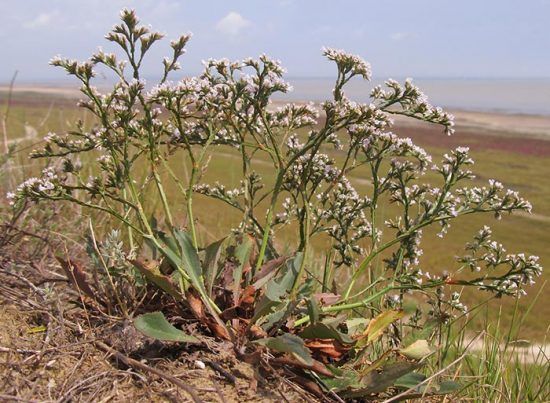
If the earth is rich in humus, then it is recommended to spill the Tatar Kermek 1-2 times with a salt solution: 40-50 g per bucket of water
Pruning
In autumn, when the branches are bare, the aerial part of the plant must be cut off. Leave the stems 3-5 cm above the soil level.
Preparing for winter
In order for the Tatar Kermek to endure the winter well, the plants can be wrapped in straw, spruce branches or non-woven material. The shelter is removed when the snow has completely melted.
Pests and diseases
Kermek Tatar is resistant to diseases, little susceptible to pest attacks. The main cause of plant disease is over-watering. In this case, the bushes can be affected by fungi and mold. From the first, industrial fungicides and a solution of copper sulfate help. And the composition of colloidal sulfur fights well against black or white mold. Aphids can attack a weakened plant, especially if there are many anthills on the site. In this case, you can use folk remedies by treating with soapy water and alcohol. Or spray the pests with an appropriate insecticide.
Useful properties of a perennial
Kermek Tatar has healing properties. Its root contains valuable biologically active substances:
- natural phytoncides;
- organic acids - ellagic and gallic;
- tannins.
It has been established that the Tatar Kermek has a beneficial effect on the human body, as:
- effective pain reliever;
- astringent and fixing agent;
- relieves inflammation and stops bleeding;
- increasing regeneration;
- excellent antiseptic and natural antibiotic.
The root of the plant is used fresh and dried in decoctions, powders, as an internal and external agent. For skin problems, baths and lotions with a decoction of Kermek Tatar root are recommended.
Conclusion
The perennial Tatar Kermek, whose photo brings back pleasant memories of the hot summer and flowering meadows, is popular with gardeners as a decorative decoration for personal plots. Every corner of the garden is transformed, as soon as this deceptively fragile shrub blooms. Caring for a herbaceous perennial is completely uncomplicated, and available for novice florists. Kermek Tatar is sensitive to the presence of sunlight, does not tolerate excess water well - this must be taken into account when planting.








